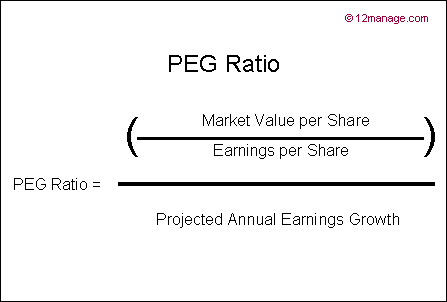Price Earnings Ratio
Post on: 12 Апрель, 2015 No Comment

The price earnings ratio is the price currently paid on the open market for a share of a company’s stock, divided by its earnings per share. The price earnings ratio reveals the multiple of earnings that the investment community is willing to pay to own a company’s stock. A very high multiple indicates that investors believe the company’s earnings will improve dramatically, while a low multiple indicates the reverse. If the ratio is already high, then there is little chance for the stock price to move even higher, so there is significant risk that the share price will slide lower in the future.
The investment community usually forces a stock price upward based on future expectations for such issues as new patents, new products, changes in the laws impacting a company, and so forth.
It is possible to build an expected price earnings ratio by dividing future earnings expectations per share into the current market price. This is not a firm indicator of where the ratio will actually be in the future, but is a good basis for deciding whether the stock is undervalued or overvalued.
If a company is currently reporting a loss, then it has no price earnings ratio at all.
The price earnings ratio can be derived as either the current market price per share, divided by earnings per share, or as the total current company market capitalization, divided by net after-tax earnings. The earnings listed in the denominator of the ratio are for the preceding 12 months. The results of either calculation are the same. The formula using individual share information is:
Current market price per share
Earnings per share
The earnings per share in the denominator are based on fully diluted earnings per share.
The formula using full-company financial information is:
Current company market capitalization
Net after-tax earnings
For example, ABC International’s common stock is currently selling for $15 per share on the open market. It reported $3.00 of fully diluted earnings per share in its last annual report. Therefore, its price earnings ratio is:

$15 Market price per share
$3 Earnings per share
= 5 price earnings ratio
There are several issues to be aware of if you elect to use this ratio. Areas of concern are as follows:
- Earnings information can be manipulated by accelerating or deferring expense recognition, as well as a variety of revenue recognition schemes. A more accurate measure of the value that the investment community is placing on a company’s stock is the price to cash flow ratio. Cash flow is a much better indicator of the results of a company’s operations.
- Changes in the price earnings ratio tend to impact every company in an industry at the same time, because they are all subject to the same market forces, with slight differences between the various companies. Thus, a favorable change in the price earnings ratio may not be cause for excessive jubilation at one company for a job well done, since the change may not be caused by the company at all, but by a change in its business environment.
- Yet another issue with the price earnings ratio is that the price may fluctuate wildly in the short term, as such factors as takeover rumors and large customer orders excite investors and impact the price. Consequently, the ratio can be dramatically different if the timing of the measurement varies by just a few days.
The price earnings ratio is also known as the earnings multiple or price multiple. The price earnings ratio is sometimes referred to as the multiple. because it states the multiple of earnings per share that investors are will to pay for a stock.
Similar Ratios














